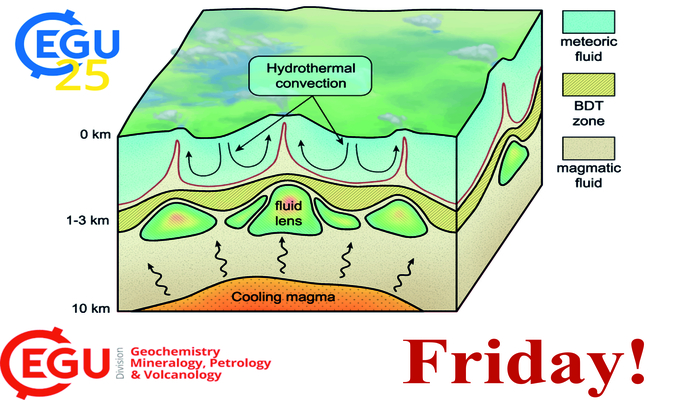
Finally, the last day arrived. It’s time to enjoy the last moment of the 2025 General Assembly.
Today, there are a total of 5 sessions solely organised by the GMPV-
- In line with the significant breakthroughs in modern Earth Science, particularly due to the development in observational, analytical, and modelling methods by introducing micro to nano analytical tools, GMPV has scheduled a session (GMPV7.5) on the application of these tools and cutting-edge modelling or experimental methods in conventional research. The session will also shed light on emerging AI methods, including machine learning and deep learning-based geobarometry, image segmentation, and classification, which help automate and refine data interpretation in volcano-magmatic dynamics, thereby revealing many hidden mysteries in Igneous Petrology.
- The GMPV8.1, dedicated to the Volcanic processes, will highlight the interaction of tectonics, deformation and geodesy and help advance our primary understanding of any deformation of active and non-active volcanoes and their implications for hazards.
- The session GMPV8.3 represents an intricate interplay of a diverse range of geoscientific disciplines covering geophysics, geochemistry, microbiology, and remote sensing for a better understanding of modern and paleo fluid-driven systems in the upper crust with a focus on the geysers, hydrothermal vents, mud volcanoes and cold seeps. The session will be highly attractive, particularly in light of recent progress in Geobiological research.
- Another interdisciplinary session, GMPV8.4, will provide insights into understanding the magmatic processes at depth and when ascending towards the surface. It will also portray the interaction among the magmatic processes, conduit dynamics, eruptive behaviour, and emplacement mechanisms. The session will draw interest, particularly by enlightening us on the plausible mitigation measures for volcanic hazards.
IAVCEI Scientific Assembly in Geneva, Switzerland, is knocking at the door.
At this juncture, the GMPV Division, under the auspices of the IAVCEI Commission on Tephra Hazard Modelling, will bring a session “GMPV9.2” to address the unresolved issues in modelling pre- and post-eruptive phenomena, including volcanic emissions and their atmospheric lifetime. The session will encompass the research outcomes based on field and satellite data analysis, physico-mathematical formulations of natural processes, and numerical methods. Furthermore, the potential of machine learning techniques to process multidisciplinary data for an advanced understanding of volcanic hazards will also be evaluated.
GMPV believes in collaboration and cooperation..Let's hold our hands together
- There is a session “SM7.1” co-organised with the Seismology Division on the monitoring and investigations of volcanic seismicity, which will try to resolve many challenges by incorporating the employment of modern instruments and Machine Learning.
We have two more sessions co-organised with the Geodynamics Division.
- Considering the potential of the Caribbean region to serve as an ideal natural laboratory for studying long-term to short-term deformation processes along plate boundaries, the session “GD9.2” will focus on an in-depth understanding of regional geodynamics at the densely populated boundaries of the Caribbean plate, and the broader geological processes occurring in subduction and strike-slip zones.
- The GD2.3 will unravel various geochemical and geodynamic perspectives on the origin and evolution of deep-seated mantle melts. This PICO session will integrate the geochemistry and fabric of mantle xenoliths, orogenic peridotites, mantle-derived melts, and experimental simulations.
- On the other hand, the session GD7.1, co-organised by GD and TS Division, will further contribute knowledge of the long-term rheology and chemo-thermo-mechanical behaviour of the lithosphere and mantle with rock mechanics, petrographic observations, and geodynamic and thermo-mechanical modelling.
Another collaborative session, GD4.1, jointly organised by the GMPV, GD and TS Divisions, will try to provide an understanding of subduction zone processes, combining insights from global subduction zones with a focus on the western margin of South America, one of the Earth’s most significant subduction systems. Most importantly, this cross-disciplinary session will illuminate subduction zone dynamics at all scales, from the surface to the lower mantle, and in applications to natural laboratories, especially in relation to the Andes.
Apart from these, the session ‘SSP3.4’, co-organised with SSP and BG Division, will explore the field of mineralisation and diagenesis, from surface conditions to deep burial, coupling the biological, chemical, and physical mechanisms.
Considering the recent and future Mars Missions and significant development in understanding the geological processes on Mars, a session ‘PS1.4’ will be co-organised with the Geomorphology Division (GM) and the Division on Planetary and Solar System Sciences (PS). This innovative and fascinating session will delve into past and present processes, either pure Mars science or comparative planetology (including fieldwork on terrestrial analogues), as well as the modelling approaches and laboratory experiments (or any combination). The outcomes of the Mars science obtained from recent in situ and orbital measurements will be pathfinders for the upcoming missions and campaigns (ExoMars, Mars Sample Return).
So, wait for another year. Goodbye..See you all in EGU26…
For updates on our Division around the year, follow us on Facebook, BlueSky, Instagram and LinkedIn.


